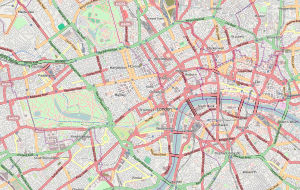Central London facts for kids

Central London is the very heart of London, England. It includes the City of London and parts of several other areas called boroughs. People have used different ways to describe Central London over time. But generally, it's known for having lots of buildings close together, very expensive land, many more people during the day than at night, and important businesses and places.
Road distances to London are traditionally measured from a spot called Charing Cross. This spot is marked by a statue of King Charles I. It's located where Strand, Whitehall, and Cockspur Street meet, just south of Trafalgar Square.
Contents
What Makes Central London Special?
Central London is unique because it's home to many important places. It has the Parliament and the Royal Palaces. You'll also find the main offices for the government and the Law Courts here. Many big companies have their main offices in Central London too.
This area is also a hub for culture and learning. It has famous museums like the British Museum and art galleries like the National Gallery and the Tate Gallery. The University of London is here, along with the main places for national ballet and opera. Many important groups, like trade unions and professional bodies, are based here.
Central London is also a huge shopping area and a center for entertainment. People come from all over London and beyond to visit its shops and theaters. Because so many important things are here, the land is very valuable. Also, many more people work or visit here during the day than live here at night. This creates a lot of traffic, making it a very busy place.
How Central London is Defined
Over the years, different groups have tried to define exactly where Central London is. These definitions are used for things like planning the city or collecting statistics.
The London Plan's Definition
Since 2004, the official plan for London, called the London Plan, has used a special area called the 'Central Activities Zone'. This zone includes the City of London and most of Westminster. It also covers parts of Camden, Islington, Hackney, Tower Hamlets, Southwark, Lambeth, Kensington & Chelsea, and Wandsworth.
This zone is described as a special place with many important activities. It has government offices, company headquarters, and embassies. It's also where most of London's financial and business services are located. Many offices for trade, media, and advertising are found here too.
For planning purposes, there's also a 'Central London sub-region'. Since 2011, this sub-region includes the boroughs of Camden, Islington, Kensington and Chelsea, Lambeth, Southwark, Westminster, and the City of London.
The 1901 Census Definition
Back in 1901, the official census defined Central London in a different way. It included the City of London and several 'metropolitan boroughs' that existed at the time. These boroughs were Bermondsey, Bethnal Green, Finsbury, Holborn, Shoreditch, Southwark, Stepney, St Marylebone, and Westminster.
Ideas for a Central London Borough (1959–1963)
Between 1959 and 1963, there were discussions about creating a single central London borough. Several ideas were put forward, but none of them were officially adopted. These ideas tried to group together the most important central areas, including major railway stations, the Tower of London, and museums. The goal was to create a single administrative area for the very heart of London.
See also
 In Spanish: Centro de Londres para niños
In Spanish: Centro de Londres para niños


